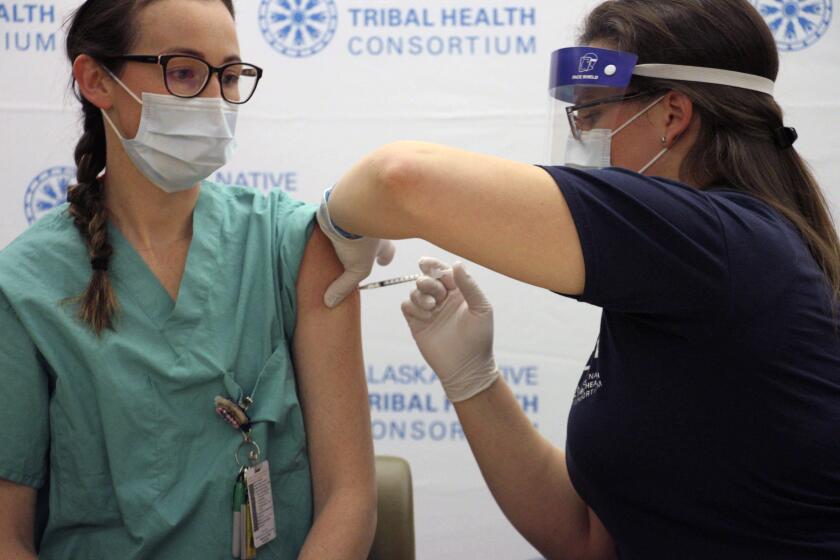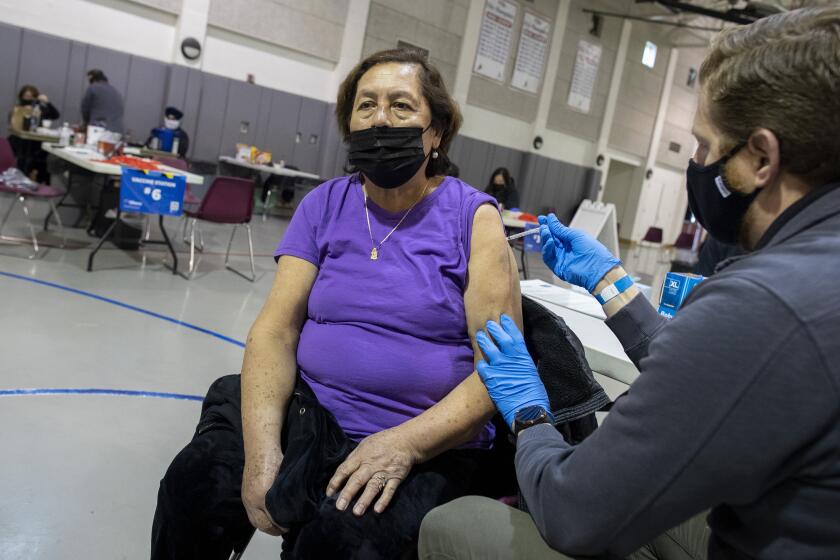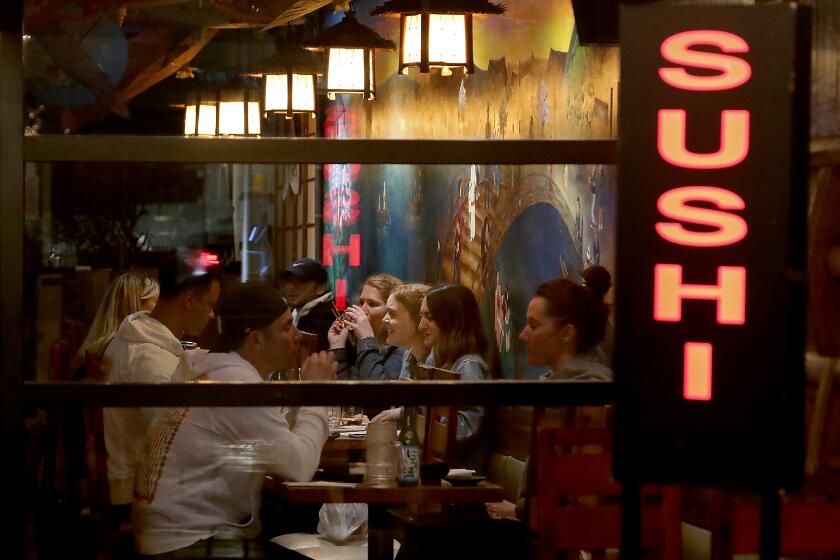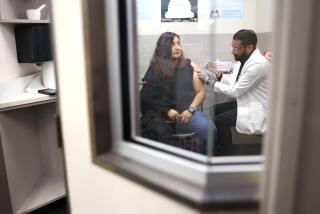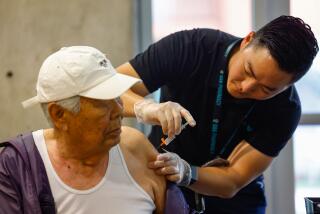California logs record-breaking week of COVID-19 vaccinations

In a sign that the state’s uneven COVID-19 vaccine rollout is significantly ramping up, nearly 1 million Californians have gotten a shot in the past two days, data show.
The last four days have seen the four highest single-day totals of vaccines administered to date, according to data compiled by The Times.
That record-setting run includes 464,249 doses reported Tuesday — an all-time high — and 400,360 on Wednesday, the second-largest daily total.
It took roughly 2½ months — from when the first vaccines arrived in mid-December until early March — for 10 million doses to be administered statewide. In the two-week period following that milestone, providers have given more than 3 million additional shots.
“The quicker we get to immunity, the quicker we will put this pandemic in the rearview mirror so we can enjoy more everyday activities without the concerns we’ve experienced in the past year,” Dr. Tomás Aragón, state public health officer and California Department of Public Health director, said in a statement Wednesday.
Alaska officials made the calculation that enforcing a hierarchy of eligibility was slowing down the effort to vaccinate as many people as quickly as possible.
Despite the recent progress, however, California continues to lag behind many other states in its vaccination efforts.
To date, roughly 23% of Californians have received at least one vaccine dose — a proportion that ranks 33rd out of all states and U.S. territories, according to data from the U.S. Centers for Disease Control and Prevention.
By comparison, 30.6% of New Mexico’s population has gotten at least one shot, as have 29.2% of Alaskans and 28.5% of those living in South Dakota.
California has done somewhat better compared with more populous states. As of Thursday, 24.1% of residents had received one shot in Pennsylvania, 23.6% in New York, 21.7% in Florida and 20.4% in Texas, CDC data show.
Two of the vaccines approved for use in the United States — one from Pfizer-BioNTech and the other from Moderna — require two doses, administered weeks apart. The third, from Johnson & Johnson, requires only one.
COVID-19 supply in California is tight. But that is expected to change soon. Here is what we know.
Vaccination efforts both in California and across the country have been hampered by supply shortages.
Last week, California received 1.7 million doses, according to Gov. Gavin Newsom. That allotment grew slightly to 1.75 million this week and was expected to be 1.8 million next week.
Swiftly vaccinating a state the size of California, officials say, would require more vaccine and a steadier supply.
To date, nearly 13.4 million shots have been administered statewide — almost 78% of the total supply that has been delivered to local public health departments and medical providers, according to the California Department of Public Health.
Officials have expressed optimism that the vaccine pipeline will significantly swell in the weeks ahead, particularly as shipments of the Johnson & Johnson vaccine, which have been interrupted by production issues, begin to arrive regularly.
“You heard it from the president himself. You heard it from the CEOs that are responsible for manufacturing these vaccines that we’re going to be in a completely different place in six or so weeks as we see the significant increase in manufactured supply,” Newsom said during a briefing Tuesday.
Nearly half of all Californians — including adults 65 and older, healthcare workers, educators, people who are incarcerated or living in homeless shelters, essential workers such as those in the food industry or emergency services, public transit workers and janitors, and residents 16 and older who have disabilities or underlying health conditions — are currently eligible for the vaccine.
The list is not exhaustive, as the state continues to offer specifications for who qualifies under the various categories.
Last week, President Biden said restrictions on who could make a COVID-19 vaccine appointment would be lifted nationwide by May 1, as supply is expected to be sufficient to meet demand.
The U.S. Department of Health and Human Services has since issued a formal order to that effect, according to Andy Slavitt, a senior advisor on the president’s COVID-19 task force.
“Even as we take steps to expand eligibility for vaccines in advance of May 1, we continue to emphasize to states the importance of prioritizing vaccinations for higher-risk populations,” he said during a briefing Wednesday.
As most California counties ease pandemic-related restrictions, attention turns to the future, and how fast a wider economic reopening can take place.
In California, Newsom has characterized equity as the “North Star” that should guide the state’s vaccination campaign.
A recent CDC report, however, found that from Dec. 14 through March 1, California ranked among the worst states in terms of vaccine distribution to its most vulnerable communities.
That’s a shortcoming state officials have readily admitted.
“We’re still not close to where we need to be,” Newsom said this week.
Just days after the end of the period covered in the CDC report, officials announced that California would start dedicating 40% of its available vaccine supplies for residents in its most disadvantaged areas, those within the lowest quartile of a socioeconomic measurement tool called the California Healthy Places Index.
But disparities persist. In the index’s highest quartile — which includes wealthier, healthier communities — roughly 15.7% of people 16 and older have received at least one vaccine dose, and 19.3% have been fully vaccinated, state data show.
By comparison, 12.1% of residents that age in the lowest quartile have received at least one dose, and only 9.6% have been fully vaccinated.
“I do think we’re making slow progress,” state epidemiologist Dr. Erica Pan said during a vaccine advisory committee meeting Wednesday.
The state is also working to better educate residents about the vaccine through local community groups’ on-the-ground efforts and a television, radio, print and digital campaign focusing on Latino, Black and Asian and Pacific Islander communities.
“We know that a lot of our communities are in what we’re calling a ‘wait-and-see’ category. They’re waiting for others to get vaccinated so that they can get vaccinated,” Dr. Martha Dominguez, with the state Department of Public Health, said Wednesday. She added that testimonials were key to getting more people to roll up their sleeves.
More to Read
Sign up for Essential California
The most important California stories and recommendations in your inbox every morning.
You may occasionally receive promotional content from the Los Angeles Times.
